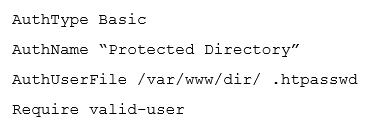In order to protect a directory on an Apache HTTPD web server with a password, this configuration was added to an .htaccess file in the respective directory:

Furthermore, a file /var/www/dir/ .htpasswd was created with the following content: usera:S3cr3t
Given that all these files were correctly processed by the web server processes, which of the following statements is true about requests to the directory?